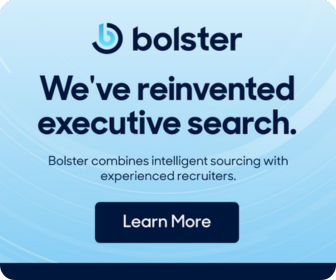How to Remove Your Full-Time Hiring Hat to Hire An Interim or Project-Based Executive
May 5, 2022
When you have an unexpected departure of an executive, or an open leadership role that needs to be filled, it can be highly disruptive to your company. You may be in the midst of projects that need completing, or have a team that needs day-to-day support that you don’t have the bandwidth to manage. Hiring an interim or project-based executive can be a great solution to give you the space to handle your immediate priorities and figure out what you need in the role long term. But unlike hiring for a full-time hire, where it is more important for your hire to check every box, filling a seat for an interim or fractional hire requires a slightly different mindset in the recruiting process.
Based on our experience at Bolster, where we work with hundreds of CEOs on on-demand hiring needs, we’ve identified a few best practices to keep in mind before you approach this process yourself. Here are some tips for successfully hiring and leveraging an interim or project-based executive:
Move quickly. Consider the duration of the interim or project to be a dating period. It doesn’t have to be a perfect long-term fit or commitment on either side. The important thing is that you are filling an urgent need without losing more time on a long executive search.
- Identify the immediate pain points – What are the key projects currently underway that need executive sponsorship / support? Does the leader need to manage a large team, or work on specific projects? Pick the set of skills that matters most and don’t dwell on things that may not seem like a perfect fit. By focusing on your short-list of priorities throughout the interview process, you and any other interviewers will be able to immediately tell when you’ve found the right person.
- Narrow your search - Find a candidate who is available when you need them, and has enough depth of experience to come in and take the reins for a short period of time. They don’t need to check every box that you’d expect a long-term hire to check. One common mistake we’ve seen CEOs make when hiring interim or project-based executives is to evaluate them on the same criteria that they would use for a long-term, full-time hire in the position. Push yourself to overcome this bias and focus on the immediate pain points you and your team identified as priorities.
- Have a short interview process and make a quick hiring decision – For an interim hire, you may be the only person interviewing which will allow you to make a quick decision on the interim candidate. At most, have one other person involved in the process.
Communicate. Proactively communicating helps to ensure the least amount of disruption for the team and company. This is particularly important in short-term roles, where time is of the essence, and it’s critical to get quick buy-in from your colleagues on the leadership team..
- To the functional team – Be upfront about the hire, and let the team know you are bringing in an interim leader so you can ensure you have time to hire the right long-term person. Let them know how much authority the interim leader has to make decisions, and which decisions you’ll be responsible for. R estate the priorities of the individual you are bringing in so no one feels threatened or unsure of the dynamic.
- To your leadership team – Determine how you want the interim or project-based leader to interact with the leadership team and communicate that to the team. Sometimes interim leaders remain a little siloed and report directly to the CEO without getting involved in long-term strategic discussions with the team (by design). Depending on the length of time, and nature of the role, you may instead want to have them fully integrate into the leadership team. Either approach works, as long as expectations are set and communicated.
- To the interim hire – Have an open and honest dialogue about what you expect and then about how things are going. Make it clear what areas you want them to focus on (and what’s not a priority for this engagement). Interim leaders are used to pivoting if your expectations change or you want them to do something differently.
Once you have your interim or project-based leader in place, you can focus on creating a long-term vision for the role, and the right interview team and process. After your interim leader has some exposure to the company and team, they can also give you input into the ideal candidate profile for a full-time hire.
The bottom line is that having an interim or project-based leader can give you the time and space to find the right long term candidate. Bolster can help you find the best executive candidates for either – or both – opportunities!
-Cathy Hawley, May 5th, 2022.
